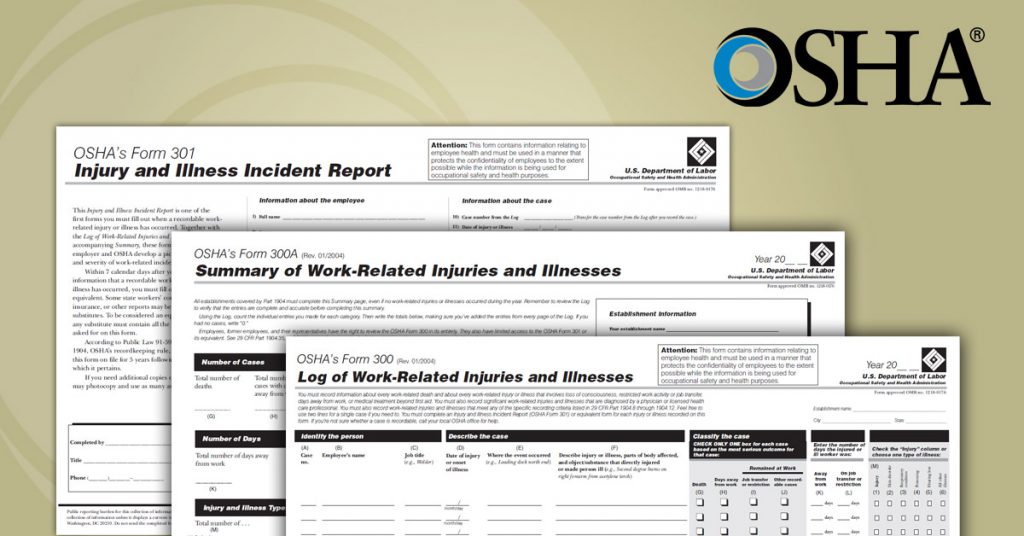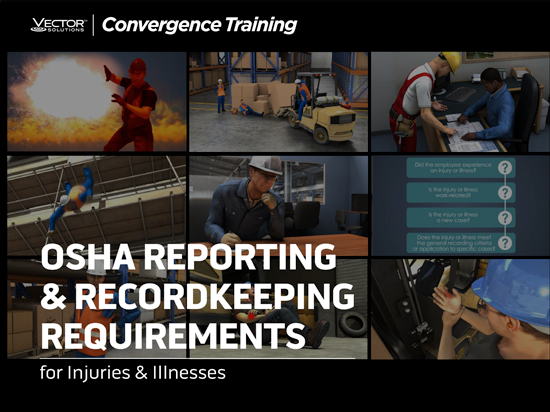
In earlier posts, we’ve described how to determine if an injury or illness at the workplace is work-related and recordable, and, if it is, how to complete OSHA’s Form 301, Injury and Illness Incident Report, and OSHA’s Form 300, Log of Work-Related Injuries and Illnesses.
If you want to review those issues, click the links below:
- Work-Related and Recordable Illnesses and Injuries
- OSHA’s Form 301: Injury and Illness Incident Report
- OSHA’s Form 300: Log of Work-Related Injuries and Illnesses
In this post, we’ll explain how and when to complete OSHA’s Form 300A: Summary of Work-Related Injuries and Illnesses.
If you want the full picture, feel free to download our FREE GUIDE TO OSHA REPORTING & RECORDKEEPING.
- Learning Management Systems
- Online Safety and Health Training Courses
- EHS & Safety Management Software
- Mobile Apps for Safety Management and Safety Training
What Is Form 300A (the Summary)?
Form 300A is a summary of the work-related injuries and illnesses that occurred at the workplace in the previous year and that should have been individually recorded on Form 300: Log of Work-Related Injuries and Illnesses.
Do You Have to Post Form 300A?
Yes. You must post the Summary (not Form 300, known as the Log) at your workplace by February 1 of the year following the year it covers. For example, if your Form 300A summarizes the workplace accidents that occurred in 2019, it should be posted by February 1, 2020.
You must keep the Summary posted until April 30 of the same year. Or, in the terms of our example, until April 30, 2020.
Do You Need a Summary for Every Establishment?
Yes. According to OSHA, “If you have more than one establishment, you must keep a separate Log (Form 300) and Summary (Form 300A) for each physical location that is expected to be in operation for one year or longer.”
Here’s how OSHA defines establishment in 1904.46:
An establishment is a single physical location where business is conducted or where services or industrial operations are performed. For activities where employees do not work at a single physical location, such as construction; transportation; communications, electric, gas and sanitary services; and similar operations, the establishment is represented by main or branch offices, terminals, stations, etc. that either supervise such activities or are the base from which personnel carry out these activities.
Do You Have to Complete and Post Form 300A Even If There Were No Work-Related Injuries and Illnesses?
Yes.
Do You Have to Keep the Form 300A on File?
Yes. You must keep the Form 300A, the Summary, on file for at least five years following the year it summarizes. The same is true of Form 300, the Log—you must keep it on file for at least five years.
Do You Have to Send Form 300A to OSHA?
The answer to this used to be no, but now it may be yes for your establishment. That’s because of the OSHA online submission requirement. Click the link you just passed to learn more, or go to OSHA’s online reporting website.
By the way, our Incident Management System can help you not only create your 300A (plus 300 plus 301), but ALSO submit your incident information online to OSHA.
How Do You Complete the Different Sections of Form 300A?
Read the explanations below.
Number of Cases:
To get these figures, find the totals of columns G-J on Form 300 (the Log). If your Form 300 is recorded on multiple pages, make sure you get the total for all pages. If you had no cases, write “0.”
Number of Days:
To get these figures, find the totals in columns K and L on Form 300 (the Log). If your Form 300 is recorded on multiple pages, make sure you get the total for all pages. If there were no days away from work or days on job transfer or restriction, write “0.”
Injury and Illness Types:
To get these figures, find the totals of section M on Form 300 (the Log) and find the totals for columns 1-6.
If your Form 300 is recorded on multiple pages, make sure you get the total for all pages. If you had no injuries or illnesses of a specific type, write “0.”
Employment Information:
To determine the “Annual average number of employees,” follow these steps:
A. Add the total number of employees your establishment paid in all pay periods during the year. Include all employees—full time, part-time, temporary, seasonal, salaries, and hourly.
Total number of employees paid in all pay periods (1) = ________
B. Count the number of pay periods your establishment had during the year. Be sure to include any pay periods when you had no employees.
Number of pay periods during the year (2) = ________
C. Divide the number of employees (1) by the number of pay periods (2).
(1)/(2) = ________ (3)
D. Round the answer for (3) to the next-highest whole number.
(3) rounded to next-highest whole number = ________ (4)
E. Record the whole number determined in step (4) Form 300A in the line labeled “Annual average number of employees.”
To determine the “Total hours worked by all employees last year,” first read these instructions from OSHA:
“Include hours worked by salaried, hourly, part-time, and seasonal workers, as well as hours worked by other workers subject to day to day supervision by your establishment (e.g., temporary help services workers).
Do not include vacation, sick leave, holidays, or any other non-work time, even if employees were paid for it. If your establishment keeps records of only the hours paid or if you have employees who are not paid by the hour, please estimate the hours that the employees actually worked.
If this number isn’t available, you can use this optional worksheet to estimate it.”
Next, complete the following steps:
Step A: Find the number of full-time employees in your establishment for the year.
(1) = ________
Step B: Multiply (1) by the number of work hours for a full-time employee in a year (2).
(1) x (2) = ________ (3)
Step C: (3), as determined in Step B, above, is the number of full-time hours worked.
Step D: Add the number of full-time hours worked (3) to (4), the number of any overtime hours as well as the hours worked by other employees (part-time, temporary, seasonal).
Step E: (3) + (4) = ________ (5)
Step F: Round (5) to the next-highest whole number (6).
Step G: Write the rounded value (5) determined in step F above in Form 300A in the line labeled “Total hours worked by all employees last year.”
Sign Here
According to 1904.32, a company executive must certify the Summary. This means the owner, an officer of the corporation, the highest-ranking company official working at the establishment, or his/her supervisor.
Note: You can also view instructions for determining these values in a worksheet created by OSHA.
Can I Get Some Help with Form 300 and My Other OSHA Recordables and OSHA Forms?
Absolutely!
We’ve got two great tools to help you:
Convergence Incident Management System (IMS) for OSHA Recordkeeping and More
The Convergence Incident Management Software will help you complete OSHA Forms 300, 300A, and 301, handle your online electronic submission, and much more.
Watch the video below for a quick explanation and overview.
The Convergence Training Online OSHA Recordkeeping Training Course
Get all the basics in just a few minutes with this helpful online course:
Conclusion: OSHA Form 300A, The Summary of Work-Related Injuries and Illnesses
We hope that this article on OSHA’s Form 300A, the Summary of Work-Related Injuries and Illnesses, was helpful.
Be sure to read the other related articles on the following topics:
And don’t forget to download the FREE GUIDE TO OSHA REPORTING & RECORDKEEPING below.

Free OSHA Injury & Illness Reporting & Recordkeeping Guide Download
Download this free guide to learn what you need to know about OSHA requirements for injury & illness reporting and recordkeeping.
Have you seen any discussion about updating the 300 in light of the new reporting criteria 2015? I realize these are two different subjects, when you have to report an incident to OSHA & what you must record on your log, but I’m surprised there is no discussion of changing the recording aspects as well.